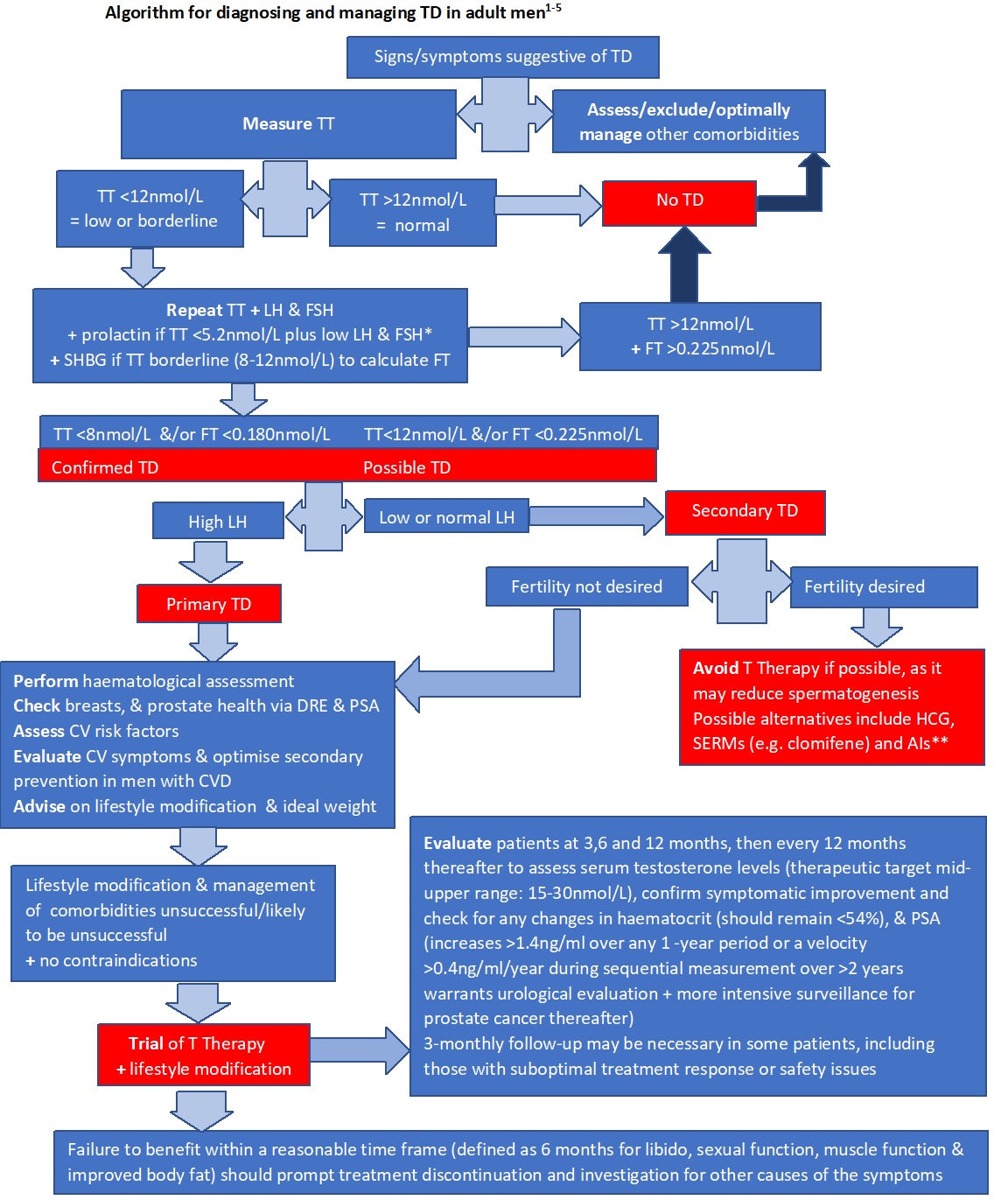investigation in testosterone deficiency
Last edited 06/2018
Blood tests - measurement of morning basal testosterone, LH, FSH, PRL - measurement of the basal levels of testosterone, LH and FSH will allow distinction between gonadal disease and hypothalamic-pituitary disease (1)
- primary hypogonadism - elevated gonadotrophin levels and low testosterone
levels
- secondary hypogonadism - low to normal gonadotrophin levels and low testosterone levels
When considering a diagnosis of symptomatic TD, other blood investigations should include:
- haematocrit as part of FBC
- prostate specific antigen (PSA), with appropriate counselling
- Appropriate tests according to physical findings and to determine cardiovascular risk
Total testosterone (TT) should be measured before 11am (2,3) with a reliable method, on at least two separate occasions,(3) preferably 4 weeks apart. Fasting levels should be obtained where possible, (3)as non-fasting levels may be up to 30% lower (3)If TT is low or borderline (<12 nmol/L):
- Measure sex hormone-binding globulin to calculate free testosterone (FT: an online FT calculator and downloadable app, sponsored by the Primary Care Testosterone Advisory Group, can be found at: http://www.pctag.uk/testosterone-calculator/)
- Measure serum luteinising hormone (LH) to differentiate primary from secondary TD.
- Measure follicle stimulating hormone (FSH) if fertility is an issue
Biopsy of the testes may be necessary for diagnosis but rarely reveals a treatable pathology.
Other investigations may be indicated and include:
- skull radiology including a pituitary CT scan
- semen analysis
- chromosomal analysis e.g. Klinefelter's disease
- bone age estimation
Asuggested algorithm for assessment of possible testosterone deficiency in primary care (1):

- Key points (contributor: Professor Mike Kirby 5/6/2018):
- an acute illness may cause a fall in testosterone levels, therefore
investigate suspected testosterone deficiency once any acute illness has
fully resolved
- most discriminant symptoms associated with low testosterone (<12nmol/L)
are: low libido, loss of early morning erections & erectile dysfunction
- particularly in combination
- consider potentially reversible factors that may be causing a low testosterone,
that can be addressed - concurrent illness, certain drugs (prescribed
or otherwise e.g. ketoconazole, cimetidine, spironolactone, chemotherapy,
opioids) and lifestyle factors (e.g. excessive alcohol; stress; significant
weight gain/obesity, excessive exercise etc.).
- an acute illness may cause a fall in testosterone levels, therefore
investigate suspected testosterone deficiency once any acute illness has
fully resolved
Reference:
- Lunenfeld B, Mskhalaya G, Zitzmann M, et al. Recommendations on the diagnosis, treatment and monitoring of hypogonadism in men. Aging Male 2015;18:5-15.
- Dohle GH, Arver S, Bettochi C et al. Guidelines on Male Hypogonadism. European Association of Urology 2017. Available at: http://uroweb.org/guideline/male-hypogonadism/ (Accessed May 2018).
- Caronia LM, Dwyer AA, Hayden D, et al. Abrupt decrease in serum testosterone levels after an oral glucose load in men: implications for screening for hypogonadism. Clin Endocrinol (Oxf) 2013;78:291-296.
- Lehtihet M, Arver S, Bartuseviciene I, et al. S-testosterone decrease after a mixed meal in healthy men independent of SHBG and gonadotrophin levels. Andrologia 2012;44:405-410.
- British Society of Sexual Medicine. Guidelines on the management of sexual problems in men: the role of androgens 2010. Available at: http://bssmorguk.ipage.com/wpcontent/ uploads/2017/05/UK_Guidelines_Androgens_Male_2010.pdf (Accessed May 2018).